
Eucalyptus punctata, commonly known as grey gum, is a small to medium-sized tree that is endemic to eastern Australia. It has smooth grey bark that is shed in patches, lance-shaped, curved or egg-shaped adult leaves flower buds in groups of seven, white flowers and hemispherical or cup-shaped fruit. Its leaves are one of the favoured foods of the koala.

Eucalyptus saligna, commonly known as the Sydney blue gum or blue gum, is a species of medium-sized to tall tree that is endemic to eastern Australia. It has rough, flaky bark near the base of the trunk, smooth bark above, lance-shaped to curved adult leaves, flower buds in groups of seven, nine or eleven, white flowers and cylindrical to conical or cup-shaped fruit.

Eucalyptus scoparia, commonly known as the Wallangarra white gum or willow gum, is a small to medium-sized tree that is endemic to a small area of eastern Australia. It has smooth bark, linear to lance-shaped or curved adult leaves, flower buds in groups of seven, white flowers and cup-shaped, hemispherical or bell-shaped fruit. It is restricted to a few rocky mountains near the border between New South Wales and Queensland but is widely cultivated.

Eucalyptus crenulata, commonly known as Buxton gum, silver gum or Victorian silver gum, is a rare species of medium-sized tree that is found only in the wild in a small area in Victoria but is widely planted. It has rough, compacted bark on the trunk, sessile, egg-shaped to heart-shaped leaves arranged in opposite pairs, flower buds covered with a white, powdery bloom, white flowers and cup-shaped fruit.

Corymbia gummifera, commonly known as red bloodwood, is a species of tree, rarely a mallee, that is endemic to eastern Australia. It has rough, tessellated bark on the trunk and branches, lance-shaped adult leaves, flower buds in groups of seven, creamy white flowers and urn-shaped fruit.

Eucalyptus notabilis, commonly known as Blue Mountains mahogany or mountain mahogany, is a species of small to medium-sized tree endemic to eastern Australia. It has rough, fibrous bark on the trunk and branches, lance-shaped to curved adult leaves, flower buds in groups of between seven and eleven, white flowers and hemispherical or conical fruit.

Eucalyptus deanei, commonly known as mountain blue gum, round-leaved gum, or Deane's gum, is a species of large tree endemic to New South Wales. It has smooth bark, lance-shaped leaves that are paler on the lower surface, flower buds in groups of seven to eleven, white flowers and cup-shaped to bell-shaped fruit.

Eucalyptus propinqua, commonly known as the grey gum or small-fruited grey gum, is a species of medium-sized to tall tree that is endemic to eastern Australia. It has smooth, mottled bark, lance-shaped to curved adult leaves that are paler on the lower surface, flower buds in groups of between seven and fifteen, white flowers and conical or hemispherical fruit.
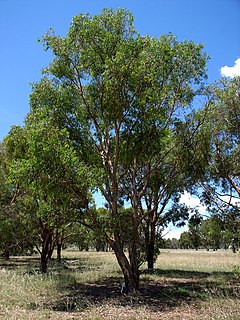
Eucalyptus parramattensis, commonly known as the Parramatta red gum or drooping red gum, is a species of small to medium-sized tree that is endemic to eastern New South Wales. It has smooth, mottled bark, lance-shaped to curved adult leaves, flower buds in groups of seven, white flowers and hemispherical fruit.
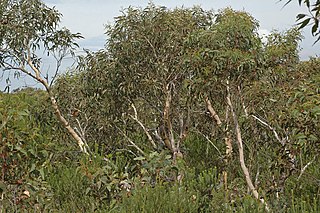
Eucalyptus racemosa, commonly known as snappy gum or narrow-leaved scribbly gum, is a species of small to medium-sized tree that is endemic to eastern Australia. It has smooth, mottled bark, lance-shaped to curved or egg-shaped adult leaves, flower buds in groups of between seven and fifteen, white flowers and cup-shaped, conical or hemispherical fruit.

Eucalyptus pellita, commonly known as the large-fruited red mahogany, is a species of medium to tall tree that is endemic to north-eastern Queensland. It has rough, fibrous or flaky bark on the trunk and branches, lance-shaped to egg-shaped adult leaves, flower buds in groups of seven, white flowers and cup-shaped to conical fruit.
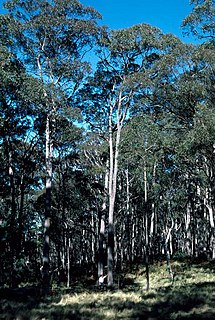
Eucalyptus laevopinea, commonly known as the silver top stringybark, is a tree that is endemic to eastern Australia. It has rough, stringy greyish bark on the trunk and larger branches, glossy green, lance-shaped adult leaves, flower buds in groups of between seven and eleven, white flowers and hemispherical or shortened spherical fruit.

Eucalyptus bridgesiana, commonly known as apple box, apple, apple gum or but-but, is a medium to large sized tree. It has rough, fibrous bark on the trunk and larger branches, smooth grey bark above, glossy green, lance-shaped adult leaves, flower buds in groups of seven, white flowers and hemispherical fruit.
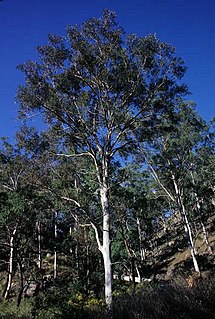
Eucalyptus major, commonly known as grey gum, is a species of tree that is endemic to a small area near the New South Wales - Queensland border. It has smooth greyish bark, lance-shaped adult leaves, flower buds in groups of seven and conical to cup-shaped fruit.
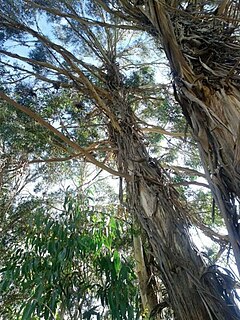
Eucalyptus nobilis, commonly known as ribbon gum or giant white gum, is a species of medium to tall tree that is native to northern New South Wales and south-east Queensland. It has a long, straight trunk with smooth, greyish bark that is shed in long ribbons, lance-shaped or curved adult leaves, flower buds in groups of seven, white flowers and cup-shaped or hemispherical fruit.
Eucalyptus perangusta, commonly known as fine-leaved mallee, is a species of mallee that is endemic to a small area on the south coast of Western Australia. It has smooth bark, glossy green, linear leaves, flower buds in groups of seven or nine, creamy white flowers and short, barrel-shaped fruit.
Eucalyptus valens is a species of mallet, a tree lacking a lignotuber, that is endemic to near-coastal areas of southern Western Australia. It has smooth bark, lance-shaped adult leaves, flower buds in groups of seven and cup-shaped fruit.

Corymbia gilbertensis, commonly known as the Gilbert River ghost gum or Gilbert River box, is a species of tree that is endemic to tropical far north Queensland. It has rough, tessellated bark on the lower part of the trunk, smooth bark above, a crown of juvenile, intermediate and adult leaves, flower buds mostly in groups of seven, creamy white flowers and cup-shaped to barrel-shaped fruit.

Corymbia jacobsiana, commonly known as Jacob's bloodwood or the stringybark bloodwood, is a species of tree that is endemic to the Northern Territory. It has rough, stringy bark on the trunk and branches, lance-shaped to elliptical or curved adult leaves, flower buds in groups of three or seven, creamy white flowers and urn-shaped fruit.
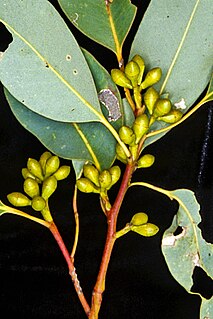
Eucalyptus grisea, commonly known as grey gum, is a species of tree that is endemic to central Queensland. It has smooth greyish bark, lance-shaped to egg-shaped adult leaves, flower buds in groups of seven, white flower and usually cup-shaped fruit.


















